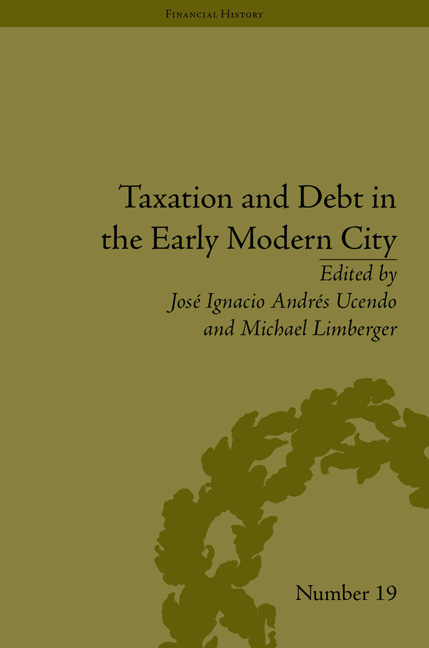Book contents
- Frontmatter
- CONTENTS
- Acknowledgements
- List of Contributors
- List of Figures and Tables
- Introduction
- 1 From Private to Public Management: Tax Farming and Customs Duties in Rome (1630–1700)
- 2 From Taxation to Indebtedness: The Urban Fiscal System of Milan during the Austrias Domination (1535–1706)
- 3 The Urban Tax System in the Kingdom of Naples (Seventeenth to Eighteenth Centuries)
- 4 Public Institutions, Local Politics and Urban Taxation in Seventeenth-Century Aragon
- 5 Taxation and Debt in the Early Modern Castilian Cities: The Case of Seventeenth-Century Madrid
- 6 Tax Collection in Spain in the Eighteenth Century: The Case of the ‘Décima’
- 7 Finances, the State and the Cities in France in the Eighteenth Century
- 8 The Making of the Urban Fiscal System of Antwerp until 1800: Excises, Annuities and Debt Management
- 9 The Dutch Financial System between Public and Private Interests: Urban Debt (1500–1700)
- 10 The Urban Fiscal System in the Habsburg Monarchy: The Case of the Austrian Hereditary Lands in the Sixteenth to Eighteenth Centuries
- 11 Taxation and Debt in Early Modern German Cities
- Notes
- Works Cited
- Index
1 - From Private to Public Management: Tax Farming and Customs Duties in Rome (1630–1700)
- Frontmatter
- CONTENTS
- Acknowledgements
- List of Contributors
- List of Figures and Tables
- Introduction
- 1 From Private to Public Management: Tax Farming and Customs Duties in Rome (1630–1700)
- 2 From Taxation to Indebtedness: The Urban Fiscal System of Milan during the Austrias Domination (1535–1706)
- 3 The Urban Tax System in the Kingdom of Naples (Seventeenth to Eighteenth Centuries)
- 4 Public Institutions, Local Politics and Urban Taxation in Seventeenth-Century Aragon
- 5 Taxation and Debt in the Early Modern Castilian Cities: The Case of Seventeenth-Century Madrid
- 6 Tax Collection in Spain in the Eighteenth Century: The Case of the ‘Décima’
- 7 Finances, the State and the Cities in France in the Eighteenth Century
- 8 The Making of the Urban Fiscal System of Antwerp until 1800: Excises, Annuities and Debt Management
- 9 The Dutch Financial System between Public and Private Interests: Urban Debt (1500–1700)
- 10 The Urban Fiscal System in the Habsburg Monarchy: The Case of the Austrian Hereditary Lands in the Sixteenth to Eighteenth Centuries
- 11 Taxation and Debt in Early Modern German Cities
- Notes
- Works Cited
- Index
Summary
The Urban Tax System
The first steady settlements of Roman duty offices date back to the second half of twelfth century. The town was at that time reduced to a scant population, but still showed off a proud municipal autonomy. All commodities brought into town were subject to the Dogana, a customs toll on traded goods of nearly 10 per cent. Goods reached Rome by land, through one of the many gates still open in the ancient Roman walls, where a preliminary small amount was paid. Then they were carried on to the central warehouse near St Eustachius Church, where they were charged with final duties before going to retail. Merchandise arriving by sea on the River Tiber from the South was discharged at the Ripa Grande Harbour – near the Trastevere district. When shipped from Northern areas, goods landed at the minor Ripetta Harbour. In any case, considering the many active city checkpoints, the whole system was quite large and required strong management in terms of buildings, staff and controls. In the mid-fifteenth century the Dogane registered tax accounts reached an average of 4,500 records per year. The town budget did not need important financial contributions, and taxation was in fact then kept at very low levels, at nearly an average 5 per cent of declared goods value.
However, in a few decades, policy faced new scenarios. Back from Avignon, the papal court landed in Rome with an ambitious programme to enlarge and consolidate the state.
- Type
- Chapter
- Information
- Taxation and Debt in the Early Modern City , pp. 13 - 28Publisher: Pickering & ChattoFirst published in: 2014



